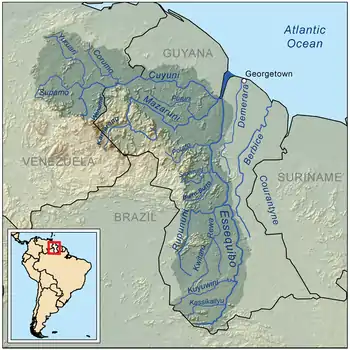Cuyuni River
The Cuyuni River is a South American river and a tributary of the Essequibo River. It rises in the Guiana Highlands of Venezuela, where it descends northward to El Dorado, and turns eastward to meander through the tropical rain forests of the Cuyuni-Mazaruni Region of Guyana. It finally turns southeastward, flowing to its confluence with the Mazaruni River.

The Cuyuni River marks the limit of the disputed territory of Guyana Essequibo for approximately 100 kilometres (62 mi).
Makarapan Mountain is a sandstone range by the Cuyuni.[1]
History
In 1681, an island in the mouth of the Cuyuni River was cleared and planted with cassava for the use of the Dutch garrison. By 1694, a new plantation on the Cuyuni River above the fort was established. By 1703 a post was established on the Pariacot Savannah, in the upper Cuyuni.
On January 2, 1895 the "Incident of the Cuyuni river", so named by the general Domingo Antonio Sifontes, was an armed confrontation between Venezuelans and British in the region of the river over the territorial dispute between Venezuela and British Guyana, which under Sifontes the Venezuelans left winners.

At dawn, British policemen led by an Inspector Barnes of England took an unoccupied military station of Venezuelan nationality, located on the left bank of the river. Barnes’ men hoisted the British flag during the day.
Captain Andrés Avelino Domínguez, second in command of Sifontes, was sent to recover the settlement. The result was the withdrawal of the British and the capture of Barnes and his men, who were taken to the General Police Station, which increased tensions between the two countries amid an internal crisis in Venezuela. [2]
Settlement
The river is a source of alluvial gold and attracts mining in the form of dredging. Illegal mining also occurs on the river banks,[3] and mining also has exacerbated the border issue between Guyana and Venezuela.[4]
Large-scale mining operation Aurora gold mine is on the Cuyuni River.[5]
Development of a hydroelectric power site is under consideration at Kamaria on the Cuyuni River.[6]
Guyana
Some of the Kali'na people live in the Cuyuni River valley, part of which is in Guyana.
Eteringbang is a border settlement[8] with an airstrip.[9] Saint Martin and Ankoko Island have been the subject of further disputes between Venezuela and Guyana. In 2015, GDF forces continued observation from Eteringbang and Kaikan and other points along the river.[10]
The town of Bartica is close to the mouth of the Cuyuni where it meets with the confluence of Essequibo and Mazaruni rivers.[11]
See also
References
- "Earth matters…". Guyana Chronicle. Retrieved January 19, 2021.
- https://www.larazon.net/2015/06/domingo-sifontes-el-venezolano-que-hizo-correr-a-los-ingleses/amp/
- "Brazilian dredge owner fined $12m for ripping up part of Cuyuni River bank". Stabroek News. September 15, 2020. Retrieved January 19, 2021.
- "Venezuela 'regrets' incursion". Stabroek News. December 13, 2007. Retrieved January 19, 2021.
- "Guyana Goldfields again assures over cyanide safety". Stabroek News. December 11, 2015. Retrieved January 19, 2021.
- "Government assessing multiple green energy options- to fuel Guyana's Development". Department of Public Information. October 26, 2016. Retrieved January 19, 2021.
- Herman, Marc (December 18, 2007). Searching for El Dorado: A Journey into the South American Rainforest on the Tail of the World's Largest Gold Rush. Knopf Doubleday Publishing Group. ISBN 978-0-307-42765-6.
- "First time school for Eteringbang". Department of Public Information. September 10, 2019. Retrieved January 19, 2021.
- "Several airstrips' upgrade underway- additional hubs to be created". Department of Public Information. May 18, 2016. Retrieved January 19, 2021.
- "Jamaica Observer Limited". Jamaica Observer. Retrieved January 19, 2021.
- "Bartica | Guyana". Encyclopedia Britannica. Retrieved January 19, 2021.